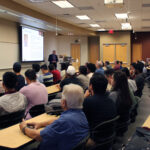
A step toward preventing waterborne disease outbreaks

Legionnaires’ disease, one of the deadliest waterborne diseases in the United States, is on the rise.
According to the Centers for Disease Control and Prevention, there were 8,453 reported cases in 2018 tallied through December 29. Often linked to water systems in buildings, nearly one in four people contract the disease in a hospital or other health care facilities.
Recent outbreaks of Legionnaires’ disease have led Arizona State University Assistant Professor Kerry Hamilton to help building owners and managers predict water quality degradation sooner, and better maintain building water systems.

Kerry Hamilton
Hamilton, a faculty member in ASU’s Ira A. Fulton Schools of Engineering and The Biodesign Center for Environmental Health Engineering, co-authored a paper recently published in Environmental Science & Technology. The paper addresses how to reduce the risk of the Legionella bacteria growing and spreading in building water systems.
She shares her thoughts on the importance of water quality research and some of her research findings.
Question: Why is it important to control pollution and preserve water quality now more than ever?
Answer: Most people in the U.S. think we have a handle on our water quality problems and drinking water isn’t something we need to worry about anymore. If anything, the recent water crisis in Flint, Michigan, and frequent Legionnaires’ disease outbreaks across the nation have demonstrated that’s not the case.
There’s even more of a push to worry about water quality in buildings because once water reaches your house from the treatment plant, the U.S. Environmental Protection Agency stops regulating it (with the exception of the Lead and Copper Rule). This gap warrants study in order to prevent negative impacts on public health. Additionally, in areas where water is scarce, reusing wastewater for different purposes could incur potential risks. That’s why it’s more important than ever to make sure people aren’t being exposed to harmful contaminants in water.
Q: What is Legionnaires’ disease, how is it contracted and why is it a public health concern?
A: Legionnaires’ disease is a pneumonia-like illness that is caused by inhaling or aspirating mists or sprays that contain Legionella bacteria. There is also a milder form of the disease called Pontiac fever. It causes illness primarily in individuals with underlying health conditions or the elderly. This is a public health concern because there have been numerous outbreaks of Legionnaires’ disease, especially in recent years. Outbreaks are often linked to water systems in buildings, especially those that are more complex or not adequately maintained. In particular, cooling towers, showers, hot tubs and fountains all produce mists that have been implicated in cases of the disease. The disease can have a potentially high case-fatality rate — 10 percent on average and 25 percent for health care-associated infections according to the CDC — making it important to prevent exposure to the bacteria.
Q: Can you explain your current research on predicting risks from pathogens in water?
A: I’m conducting research at the crossroads where environmental engineering and public health intersect. My research focuses on environmental microbiology and computational modeling. I research several different topics, although I’m currently focusing my efforts on premises plumbing systems.
To protect people from infections, we first need to understand the risks. I focus on modeling the risks from different types of pathogens in water systems. I’m particularly interested in pathogens that can grow, and even when treated to a high degree, still regrow in pipes. Legionnaires’ disease-causing bacteria is one of those pathogens. If we can better predict how water quality degrades under different circumstances, we can more efficiently target resources and prevent disease outbreaks.
My recent paper investigates how we should set concentration limits for Legionnaires’ disease-causing bacteria in building water systems. There are many guidelines in the literature about how to create a “cutoff” value, but none are based on technical reasoning. Most of the guidelines are based on what people are doing in practice. My research simulates an appropriate concentration limit based on a risk level that is consistent with other water quality policies. The goal is to give better guidance for monitoring water quality in buildings.
Q: How could your models have better predicted or prevented the recent Legionnaires’ disease outbreak in Wisconsin?
A: The recent outbreak of Legionnaires’ disease at a hospital in Wisconsin may have been linked to an effort to save water by reducing water flow during low demand periods. In some cases, increasing water or energy efficiency can create conditions where the bacteria can grow. Simultaneously managing these issues can be complicated — this is where modeling can be useful.
Risk models can be used to inform water safety plans or other recommendations made to building managers in order to reduce risks. Water quality management measures taken by building owners are designed to prevent the growth of Legionella bacteria as well as occupant exposures. As part of this approach, some facilities will monitor their water system for Legionella bacteria by testing water samples. While various guidance is available for interpreting whether the concentration that is detected presents a risk or not, there is generally not a consensus on how to interpret sampling results. We hope our study can shed some light on this issue by providing guidance on how to interpret sampling results in conventional and “green” buildings.
We used a stochastic quantitative microbial risk assessment modeling approach that accounts for concentrations of Legionella in water systems, characteristics of water systems and fixtures, and building occupant behavior. By quantifying the degree and likelihood of various events occurring, we calculated a concentration that corresponds to a reasonably low-risk level.
The goal is that building managers could compare their sample concentrations to our simulated concentrations in order to figure out if their water system might be risky. Then, they would know to take appropriate actions to reduce risks. For exposure to multiple water fixtures over time, we calculated an average water sample concentration of approximately 20 colony-forming units per liter of water, and a single sample maximum of 25 colony-forming units per liter of water for showers in non-health care settings, which is lower than some previous guidance.
Q: What initially got you interested in environmental engineering and water research?
A: I have a unique background. My undergraduate and master’s degrees are in public health, and my doctoral degree is in environmental engineering. When I started my career, I focused on toxicology. Seeing real-time changes happen as an organism was exposed to environmental contaminants was eye-opening.
Additionally, my travel experiences have fundamentally shaped my research interests. I’ve lived in Australia, Brazil, and Tanzania, among other places, and have seen people struggling to manage various water systems. I’ve seen how big of an impact this can have on public health, which has led me to pursue solutions to help improve water systems all over the world.



































